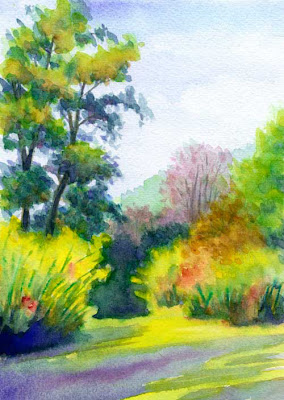Step Five : Applying colored pencil in layers to create form and depth of color
A. First color layer
First, lighten the pencil outlines by dabbing with a kneaded eraser. Using light pencil pressure, fill in the entire pear shape with Light Chrome Yellow, leaving the white highlight areas the white of the paper surface.
Because our reference photo shows the pear with all-over yellow cast to the color, you will begin with an even layer of yellow over the entire shape of the pear. With each layer of color, use uniformly light pressure when applying the colored pencil to the paper. I often will turn my paper in several directions when coloring in, to vary the direction of pencil strokes giving a more uniform quality to the layer of color.
B. Second color layer
Now you will begin to look for variations of color within the pear shape and on the stem. Observing where these variations form general shapes of color, begin with Light Yellow Ochre to block in those places of darker, warmer yellow on the pear. Add Light Green to those areas with a greenish tint. Add Cadmium Yellow and Cadmium Yellow Lemon to the brighter yellow areas on the front and light side of the pear. On the stem, use Light Yellow Ochre, Brown Ochre, Sanguine, and Light Green to block in those color shapes.
Remember to keep a light pressure when applying your colored pencil to the paper. Rotate the paper’s position to keep changing the pencil’s stroke direction.
C. Third color layer
Fill in the area of red-orange with Light Cadmium Red. Use Cadmium Orange to feather the edges of the red.
Next use Burnt Carmine to deepen the darker red areas out to the right shadowed edge. This will darken and neutralize the yellow-green on the shadowed edge of the pear.
Now add a couple of touches of Burnt Carmine to the darker edges of the stem.
*If you would like to work from a paper copy of the tutorial you can visit my Tutorial page here on this blog and follow the links to a free PDF file that you may download for yourself.
Wednesday's post will continue with step five, adding shadows with colored pencil layers.

















